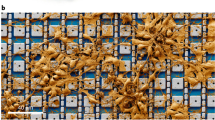Abstract
Multielectrode arrays (MEAs) are grids of substrate-integrated microelectrodes that allow for electrophysiological interrogation of dissociated cell cultures or tissue slices. Here we discuss the use of nonimplantable electrodes for studies. The methods described attempt to provide a starting point for researchers new to the field who wish to begin to utilize this powerful, but daunting technology and quickly apply the basic principles to their own research interests.
Access this chapter
Tax calculation will be finalised at checkout
Purchases are for personal use only
Similar content being viewed by others
References
Pine J (2006) A history of MEA development. In: Taketani M, Baudry M (eds) Advances in network electrophysiology using multi-electrode arrays. Springer, New York
Lein PJ, Barnhart CD, Pessah IN (2012) Acute hippocampal slice preparation and hippocampal slice cultures. Methods Mol Biol 758:115–134
Humpel C (2015) Organotypic brain slice cultures: a review. Neuroscience 305:86–98
Berdichevsky Y (2009) Microfluidics and multielectrode array-compatible organotypic slice culture method. J Neurosci Methods 178(1):59–64
Plenz D (2011) Multi-electrode array recordings of neuronal avalanches in organotypic cultures. J Vis Exp 54:e2949. https://doi.org/10.3791/2949
Johnstone AFM (2010) Microelectrode arrays: a physiologically based neurotoxicity testing platform for the 21st century. Neurotoxicology 31:331–350
Stett A (2003) Biological application of microelectrode arrays in drug discovery and basic research. Anal Bioanal Chem 377:486–495
Spijker S (2011) Dissection of rodent brain regions. In: Li KW (ed) Neuroproteomics. Humana Press, New York/Heidelberg, pp 13–26. https://doi.org/10.1007/978-1-61779-111-6_2
Dreyfus CF, Black IB (1990) Multiple approaches to brain culture. In: Conn PM (ed) Cell culture methods in neuroscience,vol 2. Elsevier, pp 3–16. https://doi.org/10.1016/B978-0-12-185254-2.50005-X
Pacifici M, Peruzzi F (2012) Isolation and culture of rat embryonic neural cells: a quick protocol. J Vis Exp 63:e3965. https://doi.org/10.3791/3965
Huettner JE, Baughmann RW (1986) Primary culture of identified neurons from the visual cortex of postnatal rats. J Neurosci 6(10):3044–3060
Finkbeiner S, Stevens CF (1988) Application of quantitative measurements for assessing glutamate neurotoxicity. Proc Natl Acad Sci U S A 85:4071–4074
Papouin T, Haydon PG (2018) Obtaining acute brain slices. Bio Protoc 8(2):e2699. https://doi.org/10.21769/BioProtoc.2699
Ting JT, Daigle TL, Chen Q et al (2014) Acute brain slice methods for adult and aging animals: application of targeted patch clamp analysis and optogenetics. Methods Mol Biol 1183:221–242
Kessler M (2008) Spontaneous activity in Purkinje cells: multi-electrode recording from organotypic cerebellar slice cultures. Brain Res 1218:54–69
Xiong G, Metheny H, Johnson BN et al (2017) A comparison of different slicing planes in preservation of major hippocampal pathway fibers in the mouse. Front Neuroanat 11:107. https://doi.org/10.3389/fnana.2017.00107. eCollection 2017
Author information
Authors and Affiliations
Corresponding author
Editor information
Editors and Affiliations
Rights and permissions
Copyright information
© 2021 Springer Science+Business Media, LLC, part of Springer Nature
About this protocol
Cite this protocol
Burley, R., Harvey, J.R.M. (2021). Multielectrode Arrays. In: Dallas, M., Bell, D. (eds) Patch Clamp Electrophysiology. Methods in Molecular Biology, vol 2188. Humana, New York, NY. https://doi.org/10.1007/978-1-0716-0818-0_6
Download citation
DOI: https://doi.org/10.1007/978-1-0716-0818-0_6
Published:
Publisher Name: Humana, New York, NY
Print ISBN: 978-1-0716-0817-3
Online ISBN: 978-1-0716-0818-0
eBook Packages: Springer Protocols




